Slow and Steady Plan
Published on Friday, 27th August 2021
Day 1 - Remove the old food
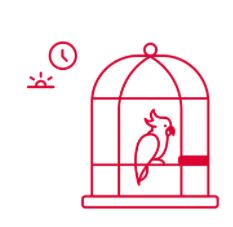 In the evening, take the old food out of the cage. The goal is to take away food at night so that the bird is hungry in the morning and more apt to try new food. Make sure they have access to fresh, clean water; as some birds will drink more during the conversion process.
In the evening, take the old food out of the cage. The goal is to take away food at night so that the bird is hungry in the morning and more apt to try new food. Make sure they have access to fresh, clean water; as some birds will drink more during the conversion process.
Tips:
- Conversion takes time and patience; the idea with this method is to allow a bird to gradually transition to a healthier, pellet-based diet over the course of a week.
- Most birds sleep at night and consume little food, so removing food from the cage at night will not harm the bird.
- This method may work better for birds that spend most of their time eating in their cages or that tend to have shyer personalities.
- This method also may work better for slightly larger birds (the size of a Conure or larger) that typically use their feet to hold food while perching, rather than feeding off the ground (as many smaller birds do).
- Since older birds typically don’t need as many calories each day as young, growing or breeding birds, this slow and steady method that involves periods in which a bird may end up eating very little may be more appropriate for mature, fully grown, non-breeding birds.
Day 2 - Put the new food in the cage
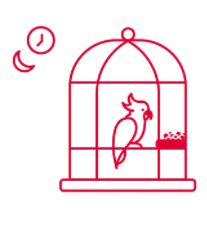 First thing in the morning, put the new food in the cage. Leave the new food in the cage for the next 4 hours. Be sure to put the new food into the cup from which a bird normally eats each day.
First thing in the morning, put the new food in the cage. Leave the new food in the cage for the next 4 hours. Be sure to put the new food into the cup from which a bird normally eats each day.
Tips:
- A bird may not initially recognize the new food in their cup as food; be patient, and try not to worry if they don't eat the new food immediately after you put it in the cage. It may take a few hours to several days.
- Some birds may not touch the new food at all during this first exposure; don’t worry – healthy birds can go several hours without eating and be fine.
- If the bird does start eating the new pelleted food, enthusiastically praise them by saying something like, “Good bird!” and using their name. If they enjoy head scratches, scratch their head through the cage bars as you praise them for tasting the new food.
- Birds work for their owners’ attention, so if the bird sees that you give them attention and praise for eating the new food, they will seek out your attention and come to anticipate it by eating the new pellets.
- If the bird doesn’t show interest in the new food, moisten it with a small amount of warm fruit juice to entice the bird to try it; however, don’t leave moistened food in the cage for more than a couple of hours, or it can spoil with the growth of yeast and bacteria.
Day 2 – Check to see if the bird is eating the new food
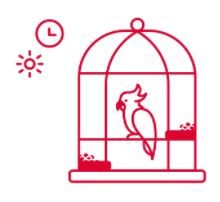 If they are eating the new food, that’s great. Continue to praise them both verbally and physically when they are eating it. If the bird isn’t eating the new food by the afternoon of Day 2, don’t be concerned; it takes some birds several days to recognize the new food as food and to try it.
If they are eating the new food, that’s great. Continue to praise them both verbally and physically when they are eating it. If the bird isn’t eating the new food by the afternoon of Day 2, don’t be concerned; it takes some birds several days to recognize the new food as food and to try it.
If you do have to offer a bird a small serving of his old food on the afternoon of Day 2, do not remove the cup of new pellets; simply offer their old food in another, different cup. Do not mix the old and new food.
Tips:
- Be sure to offer only a small portion of old food so that the bird doesn’t fill up on it and is not hungry enough to try the new food.
- Place the small portion of old food in a familiar dish but in a location the bird doesn’t typically spend a great deal of time eating or perching.
- Even when you offer the small portion of old food, do not take out the dishes of new food; the bird should be continuously exposed to the new food even when a small portion of old food is present.
Day 2 – Remove old food, replace with new food
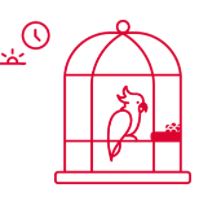 Before bedtime, remove any old food that remains in the cage. Put a portion of the new food in the cage overnight.
Before bedtime, remove any old food that remains in the cage. Put a portion of the new food in the cage overnight.
Tips:
- Once again, the goal of removing the old food overnight is to make the bird hungry so that they are more willing to try new food in the morning.
- Since the bird just ate a serving of old food the previous afternoon, they may not be hungry enough to eat the new food overnight, so don’t be alarmed if the new food still looks untouched the next morning.
Day 3 – Observe the amount of new food eaten
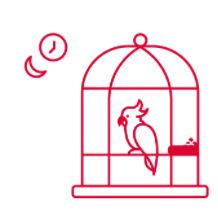 If the bird didn’t eat much overnight, they may be hungry enough by the morning of Day 3 to try the new food. If they are consuming the food, that’s great. If not, be patient and leave the new food in the cage again for 4-6 hours. The idea is to gradually extend the amount of time, from 4 hours to 6 hours, that the bird has access only to the new food to encourage them to try it.
Tips:
- If you see them taste the new food, once again, praise them verbally and physically by using their name and scratching their head to encourage them to try the new food. Healthy birds can go 4-6 hours without eating and be fine, so if the bird consumes little to nothing during this time, don’t be concerned.
Day 3 – Put some new food in the cage overnight In the evening
If the bird didn’t eat much overnight, they may be hungry enough by the morning of Day 3 to try the new food. If they are consuming the food, that’s great. If not, be patient and leave the new food in the cage again for 4-6 hours. The idea is to gradually extend the amount of time, from 4 hours to 6 hours, that the bird has access only to the new food to encourage them to try it.
Tips:
- If you see them taste the new food, once again, praise them verbally and physically by using their name and scratching their head to encourage them to try the new food. Healthy birds can go 4-6 hours without eating and be fine, so if the bird consumes little to nothing during this time, don’t be concerned.
Day 3 – Put some new food in the cage overnight In the evening,
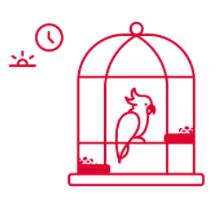 If the bird is still not eating, place another serving of the old food in the cage. Remember not to give an excessive amount of the old food, just a small serving to ensure that the bird gets some calories that day. Remove this food before bedtime. Put a portion of the new food in the cage overnight.
Tips:
- Be sure to remove any uneaten portion of old food left in the cage on the evening of Day 3 so that if the bird gets hungry overnight, the only food there for them to try is the new food.
If the bird is still not eating, place another serving of the old food in the cage. Remember not to give an excessive amount of the old food, just a small serving to ensure that the bird gets some calories that day. Remove this food before bedtime. Put a portion of the new food in the cage overnight.
Tips:
- Be sure to remove any uneaten portion of old food left in the cage on the evening of Day 3 so that if the bird gets hungry overnight, the only food there for them to try is the new food.
- Remember never to mix old food with new food, as birds will almost always select the old food to eat and ignore the new food.
Day 4 – Day 7 – Gradually extend the length of time with new food
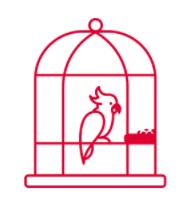 Continue to gradually extend the length of time the new food is in the cage over the next few days. Only feed the old food in the evening if the bird is not consuming the new food. The goal is to begin to completely eliminate the old food and convert over to the new food.
Continue to gradually extend the length of time the new food is in the cage over the next few days. Only feed the old food in the evening if the bird is not consuming the new food. The goal is to begin to completely eliminate the old food and convert over to the new food.
Cut back the amount of old food you offer each day until you don’t have to offer any, since the bird is now consuming an adequate number of pellets. Ideally, to ensure that the bird is consuming an adequate number of pellets each day, get a scale that weighs in grams, and weigh the bird each morning, before the eat; track the bird’s weight over the course of the conversion.
Tips:
- Once again, the idea is to gradually extend the amount of time each day, by a few hours at a time, over a period of a few days, that a bird has access to only the new food to encourage them to try it.
- Healthy birds can go a day eating little to nothing, and they will be fine; eventually, they will get hungry enough to try the new food.
- Try not to give into your concern that the bird isn’t eating over the course of a day by offering them their old food; if you do end up offering it to them, give them only a very small amount of old food so that they don't fill up on it and not be hungry enough to try the new food.
- If they do try the new food, praise them as they do both verbally by using their name and physically with head scratches to encourage them to continue to eat the new food.
- Birds converting to pellets, especially if they have been eating high-fat seeds and nuts, initially may lose a few grams – sometimes up to 10% of their body weight. This is because pellets generally have less fat than seeds and nuts.
- If the bird loses more than 10% of their body weight when converting to pellets, or they seem weak or lethargic, contact an avian veterinarian immediately
- Another way to be sure a bird is eating enough when they convert to pellets is to count their droppings each day by placing a sheet of paper towel on the cage bottom where the droppings fall. The paper towel makes it easier to see each dropping.
- A bird should produce several droppings a day (at least one every few hours, depending on what they are eating) as they transition to pellets; if you are not seeing this many droppings, especially if the bird is thin to begin with, contact an avian veterinarian to see whether he or she wants you to extend the length of the conversion process as the bird gradually makes the transition.
- The consistency of the droppings may change once the bird is consuming mostly pellets; they may be softer and moister. There is no cause for concern if you see these changes, as long as the bird is eating and active. If you see changes in droppings’ consistency, and the bird appears weak or lethargic, contact an avian veterinarian.
- Don’t be surprised if you offer a multi-colored pellet, and the bird selects out certain colors they prefer while leaving over colours they aren't interested in; this is a common behavior and not a cause for concern.
- Birds selecting out a certain color of pellets may have droppings of that color; once again, this is not a cause for concern, as long as they are eating.






